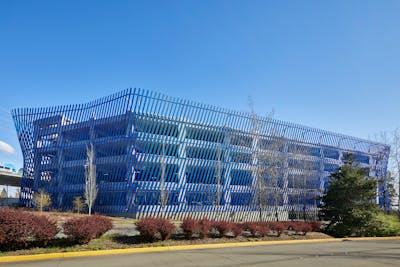
MARS Pavilion
Built by robots
Project Facts
| Location | Palm Springs, California |
| Owner | Form Found Design |
Overview
The MARS Pavilion comprises 70 unique “wishbone” style components intricately bolted together, serving as a testament to the structure’s remarkable flexibility. Conceived as a proof of concept for the collaboration of robots in construction, the project seamlessly marries the grace of steel and concrete with a fusion of precision and creative freedom.
Services
About the Project
The MARS Pavilion is the first robotically built concrete structure in southern California and explores a construction methodology in which humans and machines collaborate. The ABB robots’ precision and the fabric’s freedom were coupled to achieve an organic geometry and adjustable concrete mold. Designed in collaboration with Form Found Design, the Pavilion is derived from a catenary structure using concrete in its most natural state: compression.
Following years of research, the Pavilion awed onlookers in March 2017 at the Amazon MARS Conference (Machine learning, Automation, Robotics, Space exploration) in Palm Springs—an invite-only robotics conference organized by Jeff Bezos (Amazon’s CEO at that time) and similar to a private TED Conference. The Pavilion and a video of the design process were on exhibit at the A+D Architecture and Design Museum in the Los Angeles Arts District until October 2017.
The design is based on a catenary chain model used in physics and geometry in which the catenary is the curve that a chain or cable assumes under its weight when supported on both ends. However, in this design, the geometry is inverted so that the chain “hangs” upwards, harkening back to the world-renowned Spanish architect Antoni Gaudí’s use of inverting parabolic, hyperbolic, and catenary masonry forms in many of his famous structures, notably the Sagrada Familia.
Walter P Moore went beyond existing building code and design guides for the MARS Pavilion, as none could address this unique structure’s needs. Given that concrete is weak in tension but strong in compression, the choice to invert the catenary curve was integral to achieving the digital “chain model.” The inversion also resulted in minimum tensile forces due to flexure.
Helix Steel Micro Rebar, a steel fiber material, provided the necessary flexible strength to support the structure, while a uniform steel connection detail was used for consistent assembly. The micro rebar was used in conjunction with CTS Rapid Set Cement. Helix Steel and CTS generously sponsored the A+D Architecture and Design Museum exhibit.





